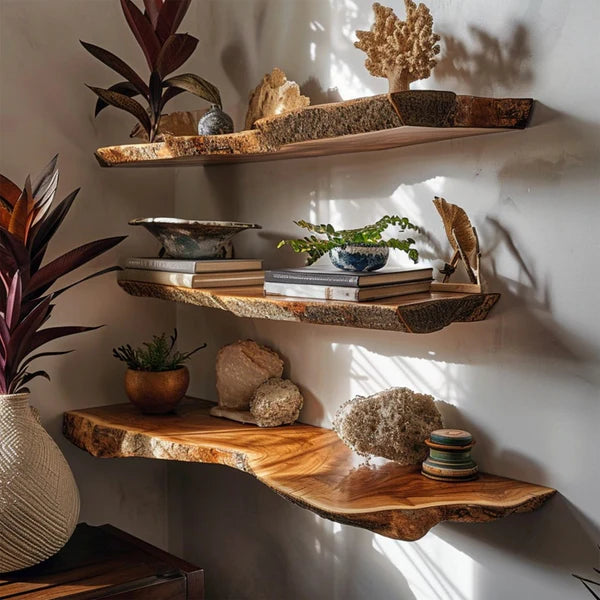Can floating shelves hold a lot of weight? This is a common question that many homeowners and interior design enthusiasts have when considering floating shelves for their living spaces. Floating shelves are loved for their modern, sleek design and their ability to create more open and functional living areas. However, there is a concern about their weight capacity, especially when it comes to holding heavy items like books, TVs, or decorative pieces.
In this post, we will explore the factors that determine how much weight a floating shelf can support, the benefits of using floating shelves in different settings, and how to ensure they are installed safely. Whether you’re wondering if a floating shelf above the couch is suitable for heavier decor, or questioning can a TV sit on a floating shelf?, we’ll provide the answers you need. Additionally, we will also discuss important design guidelines like what is the rule for the gallery wall above the couch?
Understanding Floating Shelves and Their Weight Capacity
The Material of the Shelf
The material used to create a floating shelf is one of the most important factors affecting its weight capacity. Shelves made from solid wood are the strongest and most durable, often able to hold up to 50-75 pounds.

Materials like MDF (medium-density fiberboard) or particleboard, while more affordable, are not as sturdy and are typically rated for much lighter loads, usually around 20-30 pounds. If you're planning to place heavier items on your floating shelf, it’s crucial to choose one made from a solid, strong material like hardwood or metal for better support.
Proper Wall Anchoring
A floating shelf’s ability to hold weight is also largely dependent on how well it’s anchored to the wall. The best way to ensure maximum weight capacity is by anchoring the shelf into the wall studs. This means using a stud finder to locate the studs in your wall and then drilling your shelf brackets or mounting hardware directly into these sturdy supports.

If your shelf isn’t mounted into studs, it may not hold up under heavy items, even if the shelf material itself is strong. For drywall-only installations, consider using heavy-duty anchors to provide additional support.
Shelf Size and Installation
The size and thickness of the shelf are also important considerations when determining how much weight it can hold. Thicker and wider shelves generally provide more strength, allowing them to support more weight. If your floating shelf is thin or narrow, you may need to limit the weight you place on it to prevent it from bending or breaking.
Additionally, the installation method plays a key role in weight capacity. Shelves with hidden brackets or corbels that provide extra support tend to hold more weight than shelves mounted with basic screws.
Best Uses for Floating Shelves in Your Home
Floating Shelves Above the Couch
One of the most popular placements for floating shelf above couch. These shelves allow you to display decorative items like plants, picture frames, or small books without occupying floor space. By placing a floating shelf above the couch, you can create a minimalist, open look while still adding personality to your living room. However, it’s important to keep in mind that these shelves should be used to hold light to medium-weight items to avoid overloading them.

Can You Place a TV on a Floating Shelf?
Can a TV sit on a floating shelf? While it is possible to place a television on a floating shelf, it requires careful consideration. Most standard floating shelves are not designed to support the weight of a TV, especially larger ones.

Buy now: Customizable Wooden Mushroom Shelf For Home Styling
If you intend to mount a TV on a floating shelf, you must ensure that the shelf is specifically designed for this purpose, with additional reinforcements and a strong installation method. There are also floating shelf units available that are specially made for mounting TVs, so choosing one of these is essential for ensuring the safety of your equipment.
Floating Shelves for Gallery Walls Above the Couch
If you're creating a gallery wall above the couch, floating shelves can be a great addition to the display. These shelves allow you to showcase artwork, family photos, and other decorative items without cluttering the floor.
To create a balanced and visually appealing display, use floating shelves to hold a few key pieces of art, books, or small sculptures, while leaving space for the rest of the gallery wall. Keep in mind that the shelves themselves should not overshadow the artwork and should be used sparingly to complement the design.
How to Ensure Proper Installation of Floating Shelves
Choosing the Right Anchors and Hardware
Proper installation is key to ensuring your floating shelf holds the weight you intend to place on it. Always use heavy-duty anchors that are appropriate for the wall type. If you're mounting the shelf on drywall, make sure to use anchors that can bear the weight of the shelf and the items it will hold. For plaster or brick walls, you’ll need specialized anchors designed for these materials. Additionally, check the weight rating of the mounting hardware to ensure it matches the weight of the shelf and the items you're placing on it.
Installing into Wall Studs
The most secure way to install a floating shelf is by anchoring it directly into the wall studs. Studs are the vertical wooden beams behind the drywall that provide support for heavy items. Using a stud finder to locate the studs ensures that the shelf will be securely attached to a solid foundation, allowing it to bear more weight. If you can’t find studs in the desired location, use appropriate wall anchors that are rated for higher weight capacities.

Buy now: Modern Rustic Floating Corner Shelves For Living Room
Checking the Weight Limits
Before loading up your floating shelf, make sure to check its weight limits. Shelves are typically designed with a maximum weight capacity in mind, and exceeding this limit could cause the shelf to sag or collapse. For instance, a floating shelf above the couch should only hold lightweight items like decorative pieces or small plants. If you're planning to display heavier objects like books or electronics, opt for a shelf that is specifically designed for that purpose, with reinforced supports and higher weight limits.
Conclusion
In conclusion, can floating shelves hold a lot of weight? Yes, but only if they are properly installed and used within their weight capacity. Floating shelves can be a stylish and functional addition to your home, offering a modern solution for displaying decorative items, books, or even TVs. To ensure your shelf can hold the weight you need, focus on the material, installation method, and the weight limits of both the shelf and mounting hardware.
Whether you're considering a floating shelf above the couch, wondering if a TV can sit on a floating shelf, or designing a gallery wall above the couch, always prioritize safety and proper installation to enjoy your floating shelves without worry.







Leave a comment
This site is protected by hCaptcha and the hCaptcha Privacy Policy and Terms of Service apply.